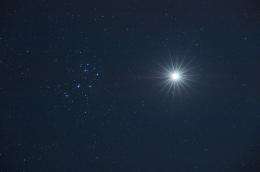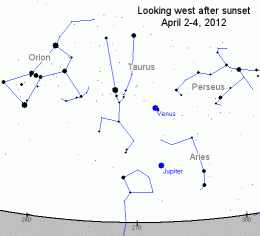Venus invades the Pleiades

This week the second planet from the sun will pass directly in front of the Pleiades star cluster. It's a rare sunset conjunction that's easy to find with the unaided eye, but best seen through binoculars or a small telescope.
The action begins on Monday evening, April 2nd, when Venus enters the outskirts of the little dipper-shaped asterism. Look west at sunset for Venus--it's the brightest thing around--then scan the area using binoculars. The conjunction will be immediately clear. The best evening to look is Tuesday, April 3rd, when the brilliant planet glides just south of the dipper's bowl. Venus exits by the handle on Wednesday, April 4th. Venus passes through the Pleiades in this way about once every 8 years.
To say this is a mixture of dissimilar things would be an understatement.

The Pleiades are elusive. You rarely find them on purpose. They're best seen out of the corner of your eye, a pretty little surprise that pops out of the night sky when you're staring elsewhere.
Venus is just the opposite. Dazzling, bright enough to cast faint shadows, it beams down from the heavens and grabs you when you're not even looking.
The Pleiades, also known as the "Seven Sisters," are a cluster of young stars. They formed barely 100 million years ago during the age of dinosaurs on Earth from a collapsing cloud of interstellar gas. The biggest and brightest members are blue-white and about five times wider than our own sun.
Because of their distance, about 400 light years away, the Pleiades are near the limit of naked-eye visibility. When Venus joins them in conjunction, it will look like a supernova has gone off inside the cluster. Venus's thick clouds reflect so much sunlight, the planet outshines every thing in the night sky except the Moon. Strangely, though, the Pleiades do not look puny in comparison, just delicately beautiful.
Look west just after sunset, and see for yourself.
Provided by Science@NASA





















